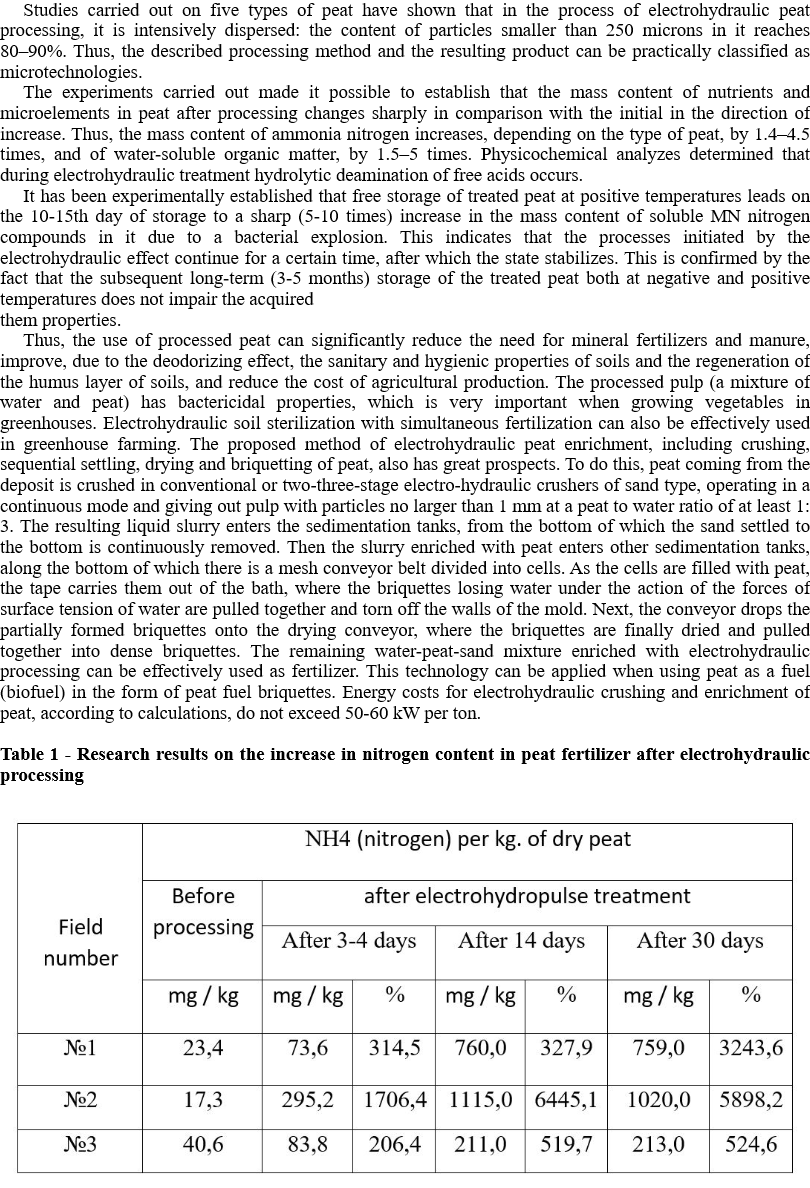






Trakonta ltd, 54031 Ukraine, Nikolaiv city, Electronnay street 81/4, E-mail: trakonta@gmail.com Tel: +380512714945; Mob, Viber: +380503180260

ELECTROHYDRAULIC PEAT PROCESSING
Trakonta ltd
ELECTROHYDRAULIC PEAT PROCESSING
ELECTROHYDRAULIC PEAT PROCESSING

The sequence of technological operations during the operation of the electro-hydraulic unit is as follows: milled peat in the loading hopper is fed by a belt conveyor to a vibrating sieve, where it is sieved, and then cleaned by an electromagnetic separator from metal inclusions. The peat feed rate is determined by the performance of the shaker and the electro-hydraulic crusher. The sifted peat is fed by a belt conveyor into the mixer tank, where water is supplied in an amount regulated by a valve damper with an actuator and determined by the moisture content of the original peat and a given consistency of the final product. Then the peat-water mixture enters the chamber of the electro-hydraulic crusher, where it is exposed to electro-hydraulic shocks. The treated substrate-slurry is pumped into the tank.
All major technological operations of peat processing are controlled and monitored automatically. The unit provides a remote control for individual operations, as well as signaling and control over operating modes. This technology formed the basis of an industrial plant for electrohydraulic peat processing in order to obtain high-quality organic fertilizer from it, a mass for pelleting seeds of various crops and fine peat mass, which is used to apply peat to the surface to prevent it from blowing out.
All major technological operations of peat processing are controlled and monitored automatically. The unit provides a remote control for individual operations, as well as signaling and control over operating modes. This technology formed the basis of an industrial plant for electrohydraulic peat processing in order to obtain high-quality organic fertilizer from it, a mass for pelleting seeds of various crops and fine peat mass, which is used to apply peat to the surface to prevent it from blowing out.
Thus, the task is to “activate” natural peat by converting useful organic matter and minerals into a form readily available for plants. The basis of this “activation” process, as a rule, is the process of destruction of the cellulose and lignin shell of an organic cell, which contains the necessary useful substances. However, technologically this is not so easy to achieve. At the moment, the main activation technologies are biochemical (microbiological), thermal ultrasonic (cavitation) and electrohydraulic.
In terms of simplicity, low cost and efficiency, electro-hydraulic peat processing technology is especially distinguished. For the application of the above methods, electro-hydraulic crushers are used, which are included as the main unit in the technological line.
In terms of simplicity, low cost and efficiency, electro-hydraulic peat processing technology is especially distinguished. For the application of the above methods, electro-hydraulic crushers are used, which are included as the main unit in the technological line.
After electrohydropulse processing, peat can be used in agriculture as an organic fertilizer, for example, to replace part of the mineral fertilizers used in the application of no-till no-till technology, since the resulting fertilizer can be used in liquid form and does not require plowing, unlike from natural peat. Also, the processed peat can be used in the microbiological, fermentation and feed industry.
In some cases, for example, when using processed peat as a raw material for the fermentation industry, after electrohydraulic processing the peat is sown with the appropriate microflora, using the effect of the "bacterial explosion".
In some cases, for example, when using processed peat as a raw material for the fermentation industry, after electrohydraulic processing the peat is sown with the appropriate microflora, using the effect of the "bacterial explosion".
Peat organic matter consists of humic and fulvic acids, bitumen, cellulose, lignin, and the mineral part of peat mainly consists of silicon, calcium, iron, aluminum and microelements. The organic matter of peat and humic acids included in it largely determine the fertility of soils, being sources of physiologically active substances that increase the vital processes of living organisms. However, these properties appear only after the corresponding processes of decomposition of organic peat and the transition of a number of its compounds into a state accessible for assimilation by plants. In nature, this process is extremely slow; therefore, the use of pure peat is effective only with sufficiently high doses of its introduction into the soil, which is economically unprofitable.
All rights reserved by Trakonta 1996 – 2021
All rights reserved by Trakonta 1996 – 2021



